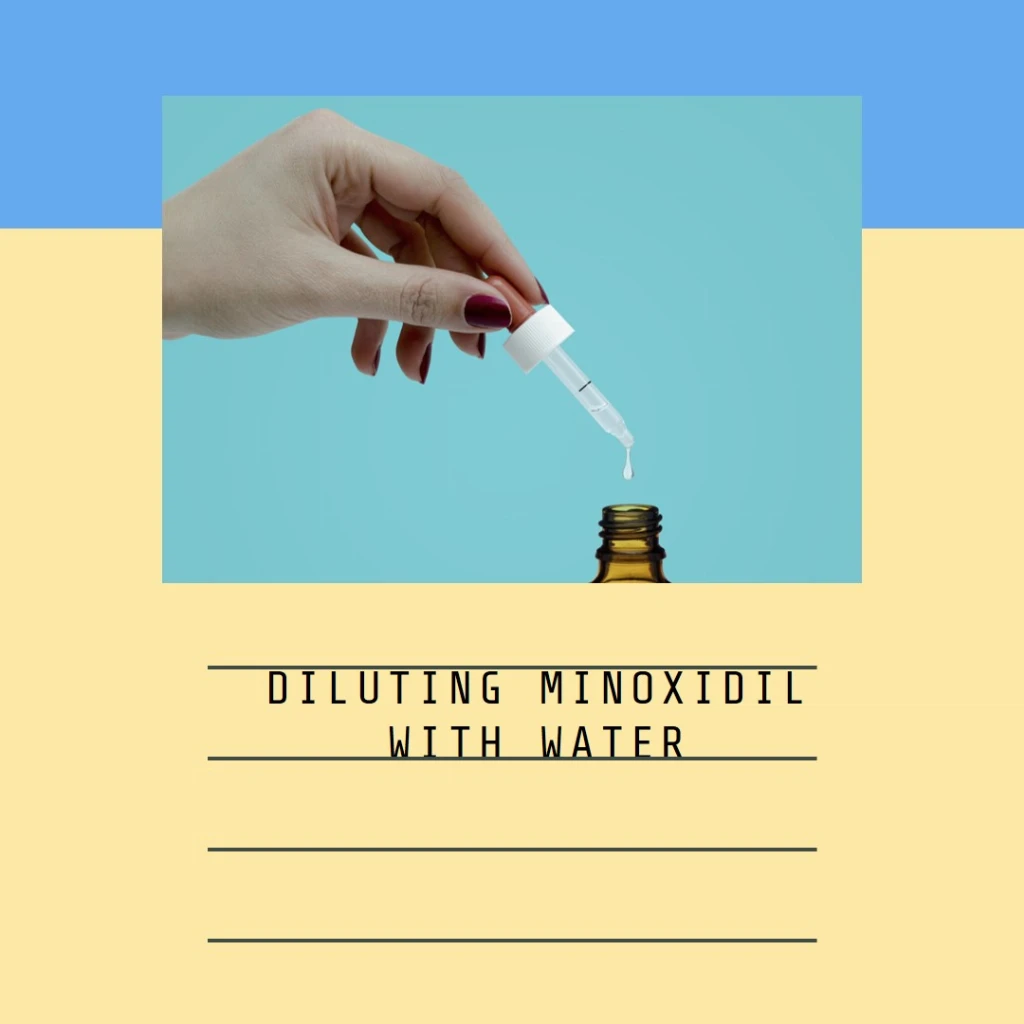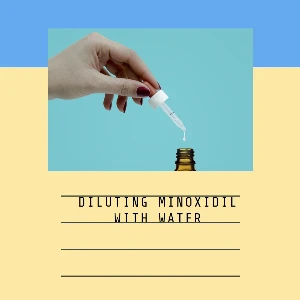Can you dilute minoxidil with water?

Share This Post
Can you dilute minoxidil with water? No, you should not dilute minoxidil with water. Minoxidil solutions are specifically formulated to ensure the correct concentration of the active ingredient for it to be effective. Diluting it would alter this concentration and could reduce its effectiveness or impact its stability and shelf life. Always use medications as directed by the product instructions or your healthcare provider.
How to dilute 5% Minoxidil to 2% concentration?
Minoxidil, a widely recognized hair loss treatment, is predominantly marketed at a 5% solution concentration. Notably, Kirkland Minoxidil, one of the top-selling brands in the USA, does not offer a 2% solution variant.
This lower concentration is particularly important for women because the U.S. Food and Drug Administration (FDA) has only approved the 5% concentration for use by men.
For those requiring a 2% concentration, an accurate dilution of the 5% solution is essential to maintain its therapeutic properties.
To formulate a 2% concentration from an existing 5% Minoxidil solution, you would need to combine one part of the 5% solution with three parts of a suitable diluent, such as deionized water or a 90% alcohol-free propylene glycol solution.
It is critical to mix these components well to ensure a uniform distribution of the active ingredient.
After achieving a homogeneous mixture, carefully transfer it back into the original or an appropriately labeled new container to avoid any mix-ups and reduce the risk of contamination.
Please note that this dilution protocol is intended strictly for liquid form Minoxidil products; it is not applicable to foam formulations due to their different vehicle composition.
For optimal results, it is recommended that the newly diluted 2% Minoxidil solution be used within a three-month period.
Additionally, be mindful of the expiration dates of the original product and the diluent to avoid using compromised ingredients that may affect the safety and effectiveness of the treatment.
Can I mix minoxidil with other products?
When considering mixing minoxidil with other products, there are several reasons why caution is advised:
- Absorption: Minoxidil is formulated to penetrate the scalp effectively when used alone. Mixing it with other substances might change its absorption properties, potentially reducing its effectiveness or causing unpredictable effects.
- Chemical Interactions: Minoxidil could chemically interact with ingredients in other products. These interactions could deactivate minoxidil or the other substances, or worse, create harmful compounds.
- Irritation and Sensitivity: Combining products could increase the risk of skin irritation or allergic reactions, especially if the other products contain alcohol, fragrances, or other irritants.
- Dosing Accuracy: Mixing minoxidil with other products may inadvertently alter the dosage, making it difficult to know how much minoxidil you’re actually applying.
- Product Stability: Minoxidil’s stability could be compromised when mixed with other formulations, leading to a reduction in shelf-life or efficacy.
If you are looking to treat multiple scalp conditions simultaneously, or wish to maintain a hair care routine alongside minoxidil use, discuss your options with a healthcare provider. They may recommend:
- Timing: Applying minoxidil separately at a different time from other products to prevent interaction.
- Order of Application: If using multiple products, they might suggest an order of application that allows for optimal absorption and effectiveness.
- Product Selection: Suggesting compatible products that are less likely to interact negatively with minoxidil.
Always follow the instructions provided with your minoxidil product and consult a professional before making any changes to your treatment protocol.
So, in short, Diluting minoxidil with water is highly inadvisable, as it can significantly alter the medication’s efficacy and absorption rate. Furthermore, extreme care must be taken if there is any consideration to mix minoxidil with other hair growth products. Such combinations can potentially lead to unforeseen chemical reactions or diminish the potency of the minoxidil treatment, thereby impacting its intended benefits.
Can I mix minoxidil solution with finasteride?
Mixing the minoxidil solution directly with finasteride is generally not advisable. Minoxidil is a topical solution, typically applied to the scalp to stimulate hair growth and is effective when used as directed.
Finasteride, on the other hand, is primarily prescribed in tablet form to be taken orally and works by inhibiting the hormone responsible for hair loss.
While both medications serve to combat hair loss, they do so through distinct mechanisms of action.
Minoxidil acts as a vasodilator, improving blood flow to hair follicles, whereas finasteride inhibits the enzyme 5-alpha-reductase, reducing the levels of dihydrotestosterone (DHT) that cause hair follicles to shrink.
Introducing finasteride directly into a minoxidil solution could not only potentially destabilize the formulation of one or both medications but also may impact absorption rates or increase the risk of adverse reactions.
Additionally, topical versions of finasteride are formulated especially for that route of administration and are not simply created by dissolving finasteride tablets in a solution.
For these reasons, it’s crucial to adhere to the prescribed methods of application and to consult with a healthcare provider before making any changes to how you take or apply these medications.
If you are considering combining treatments, a healthcare provider may prescribe a compounded product that safely incorporates both medications in a manner that ensures their stability and efficacy.
How to use rosemary oil with minoxidil?
When using rosemary oil with minoxidil for hair treatment, it is essential to follow these steps:
- Patch Test: Before combining rosemary oil with minoxidil, perform a patch test to ensure you do not have an allergic reaction to either substance. Apply a small amount of rosemary oil diluted with a carrier oil (such as coconut or jojoba oil) to your skin and wait for 24 hours to observe any adverse reactions.
- Consultation: Speak with a healthcare provider or dermatologist to ensure that it is safe for you to use both products together, as they may provide professional advice tailored to your specific condition.
- Application:
- Minoxidil: Follow the instructions provided with your minoxidil product. It usually involves applying the solution or foam directly to the scalp in the hair loss area.
- Rosemary Oil: Dilute a few drops of rosemary essential oil with a carrier oil like coconut oil before application to avoid irritation.
- Timing: It’s generally recommended to apply minoxidil twice a day. You could use rosemary oil at a different time of day to prevent any potential interactions on the scalp. For example, you might apply minoxidil in the morning and evening and use the rosemary oil treatment in the afternoon. After applying minoxidil, wait at least 4 hours before using the oil.
- Separate Use: You may choose to use rosemary oil and minoxidil on alternate days instead of the same day to minimize any potential scalp irritation.
- Wash Hands: After applying minoxidil or rosemary oil, wash your hands thoroughly to prevent transferring the products to other parts of your body or into your eyes.
- Monitor Progress: Keep track of your hair’s response to the treatment over several months, as it may take time to see results.
Remember that individual responses to such treatments can vary, and what works for one person may not work for another. Always use both products according to their specific instructions unless directed otherwise by a healthcare professional.
Final Verdict
So, can you dilute minoxidil with water?
Minoxidil is a medication designed to help with androgenetic alopecia, and it’s not recommended to dilute the product with water. This is because when minoxidil is mixed with water, it can significantly reduce its efficacy and can even lead to skin irritation. Diluting minoxidil could also cause the active ingredient to become deactivated, rendering the product useless.



